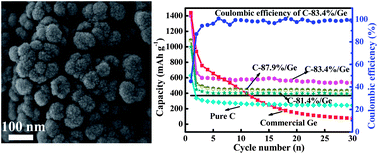Hierarchically porous germanium-modified carbon materials with enhanced lithium storage performance†
Abstract
In this work, hierarchically porous germanium-modified carbon materials (C/Ge) have been successfully synthesized by a facile hydrothermal method followed with a subsequent annealing treatment. The C/Ge nanocomposites have a unique hierarchically microporous–mesoporous structure, with a surface area of 331 m2 g−1. The C/Ge composites exhibit improved capacity, cycling performance and rate capability when used as an anode material, compared with the unmodified carbon and commercial germanium. This superior electrochemical performance could be ascribed to two points. On the one hand, such a hierarchically porous carbon would be beneficial to store and insert the lithium, and therefore the pore-transport system would allow the accessibility of those sites by lithium ions. At the same time, the carbon layers can effectively increase the electrode conductivity, and serve as a


 Please wait while we load your content...
Please wait while we load your content...